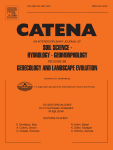Ver ítem
- xmlui.general.dspace_homeCentros Regionales y EEAsCentro Regional Buenos Aires SurEEA BalcarceArtículos científicosxmlui.ArtifactBrowser.ItemViewer.trail
- Inicio
- Centros Regionales y EEAs
- Centro Regional Buenos Aires Sur
- EEA Balcarce
- Artículos científicos
- Ver ítem
Effect of intensified cropping sequences on soil physical properties in contrasting environments
Resumen
Soybean (Glycine max (L.) Merr.) monoculture contributes to soil degradation. Intensification of soybean-based sequences through polyculture, cover crops (CC), and crop fertilization can enhance soil physical quality and help mitigate its degradation. We assessed the effect of intensification practices in cropping sequences with soybean predominance on soil physical quality indicators in contrasting soils. Treatments included soybean monoculture with and
[ver mas...]
Soybean (Glycine max (L.) Merr.) monoculture contributes to soil degradation. Intensification of soybean-based sequences through polyculture, cover crops (CC), and crop fertilization can enhance soil physical quality and help mitigate its degradation. We assessed the effect of intensification practices in cropping sequences with soybean predominance on soil physical quality indicators in contrasting soils. Treatments included soybean monoculture with and without phosphorus (P) and sulfur (S) fertilization, CC/PS-fertilized soybean, nitrogen (N)-fertilized CC/PS-fertilized soybean and NPS-fertilized crop rotation including wheat, corn, soybean and CC. Four long-term experiments (10 yr) were established in sites with contrasting edaphoclimatic conditions, and initial soil organic carbon (SOC), where we evaluated bulk density (BD) and aggregate stability (AS). The BD was mostly unaffected by treatments, whereas AS responded to intensification practices at all sites, increasing over 50% as compared with soybean monoculture. Differences in BD and AS among sites were mostly explained by soil texture and initial SOC. On the contrary, AS differences among treatments were not driven by texture, but by the soil degradation at the beginning of the experiments (calculated as the ratio between SOC when experiments were established and the SOC of pristine soil). Therefore, regardless of soil texture, more degraded soils responded to a greater extent to intensification practices in soybean-based rotations.
[Cerrar]

Fuente
Catena 207 : 105690 (Diciembre 2021)
Fecha
2021-08-27
Editorial
Elsevier
ISSN
0341-8162
Documentos Relacionados
Formato
pdf
Tipo de documento
artículo
Proyectos
(ver más)
INTA/2019-PE-E2-I052-001/2019-PE-E2-I052-001/AR./Desarrollo y aplicación de tecnologías para el control de la erosión y degradación de suelos
INTA/2019-PE-E1-I011-001/2019-PE-E1-I011-001/AR./Intensificacion Sustentable de la Agricultura en la Region Pampeana
INTA/2019-RIST-E1-I503-001/2019-RIST-E1-I503-001/AR./Red de ensayos de larga duración
INTA/PNCER-022421/AR./Diagnostico, reposición de macronutrientes y tecnología de la fertilización.
INTA/PNCYO-1127033/AR./Manejo nutricional de cereales y oleaginosas para la intensificación sustentable de los sistemas productivos
Palabras Claves
Derechos de acceso
Restringido
 Excepto donde se diga explicitamente, este item se publica bajo la siguiente descripción: Creative Commons Attribution-NonCommercial-ShareAlike 2.5 Unported (CC BY-NC-SA 2.5)
Excepto donde se diga explicitamente, este item se publica bajo la siguiente descripción: Creative Commons Attribution-NonCommercial-ShareAlike 2.5 Unported (CC BY-NC-SA 2.5)

